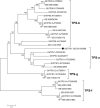Characterization of a Novel Insect-Induced Sesquiterpene Synthase GbTPS1 Based on the Transcriptome of Gossypium barbadense Feeding by Cotton Bollworm
- PMID: 35909734
- PMCID: PMC9326391
- DOI: 10.3389/fpls.2022.898541
Characterization of a Novel Insect-Induced Sesquiterpene Synthase GbTPS1 Based on the Transcriptome of Gossypium barbadense Feeding by Cotton Bollworm
Abstract
When attacked by insect herbivores, plants initiate sophisticated defenses mediated by complex signaling networks and usually release a blend of functional volatiles such as terpenes against infestation. The extra-long staple cotton Gossypium barbadense cultivated worldwide as natural textile fiber crop is frequently exposed to a variety of herbivores, such as cotton bollworm Helicoverpa armigera. However, little is known about insect-induced transcriptional changes and molecular mechanisms underlying subsequent defense responses in G. barbadense. In the current study, transcriptome changes in G. barbadense infested with chewing H. armigera larvae were investigated, and we identified 5,629 differentially expressed genes (DEGs) in the infested cotton leaves compared with non-infested controls. H. armigera feeding triggered complex signaling networks in which almost all (88 out of 90) DEGs associated with the jasmonic acid (JA) pathway were upregulated, highlighting a central role for JA in the defense responses of G. barbadense against target insects. All DEGs involved in growth-related photosynthesis were downregulated, whereas most DEGs associated with defense-related transcript factors and volatile secondary metabolism were upregulated. It was noteworthy that a terpene synthase gene in the transcriptome data, GbTPS1, was strongly expressed in H. armigera-infested G. barbadense leaves. The upregulation of GbTPS1 in qPCR analysis also suggested an important role for GbTPS1 in herbivore-induced cotton defense. In vitro assays showed that recombinant GbTPS1 catalyzed farnesyl pyrophosphate and neryl diphosphate to produce three sesquiterpenes (selinene, α-gurjunene, and β-elemene) and one monoterpene (limonene), respectively. Moreover, these catalytic products of GbTPS1 were significantly elevated in G. barbadense leaves after H. armigera infestation, and elemene and limonene had repellent effects on H. armigera larvae in a dual-choice bioassay and increased larval mortality in a no-choice bioassay. These findings provide a valuable insight into understanding the transcriptional changes reprogramming herbivore-induced sesquiterpene biosynthesis in G. barbadense infested by H. armigera, which help elucidate the molecular mechanisms underlying plant defense against insect pests.
Keywords: GbTPS1; Helicoverpa armigera; extra-long staple cotton; induced defense; sesquiterpene biosynthesis; transcriptome sequencing; β-elemene.
Copyright © 2022 Zhang, Liu, Huang, Kou, Teng, Lv, Han and Zhang.
Conflict of interest statement
The authors declare that the research was conducted in the absence of any commercial or financial relationships that could be construed as a potential conflict of interest.
Figures








Similar articles
-
Functional characterization of a terpene synthase responsible for (E)-β-ocimene biosynthesis identified in Pyrus betuleafolia transcriptome after herbivory.Front Plant Sci. 2022 Nov 21;13:1077229. doi: 10.3389/fpls.2022.1077229. eCollection 2022. Front Plant Sci. 2022. PMID: 36479507 Free PMC article.
-
Dynamic transcriptome analysis and volatile profiling of Gossypium hirsutum in response to the cotton bollworm Helicoverpa armigera.Sci Rep. 2015 Jul 7;5:11867. doi: 10.1038/srep11867. Sci Rep. 2015. PMID: 26148847 Free PMC article.
-
Functional characterization of a novel terpene synthase GaTPS1 involved in (E)-α-bergamotene biosynthesis in Gossypium arboreum.Int J Biol Macromol. 2024 Nov;281(Pt 1):136081. doi: 10.1016/j.ijbiomac.2024.136081. Epub 2024 Sep 30. Int J Biol Macromol. 2024. PMID: 39357711
-
Integrative physiology and transcriptome sequencing reveal differences between G. hirsutum and G. barbadense in response to salt stress and the identification of key salt tolerance genes.BMC Plant Biol. 2024 Aug 21;24(1):787. doi: 10.1186/s12870-024-05515-5. BMC Plant Biol. 2024. PMID: 39164616 Free PMC article.
-
Genome-wide transcriptomic and proteomic analyses of bollworm-infested developing cotton bolls revealed the genes and pathways involved in the insect pest defence mechanism.Plant Biotechnol J. 2016 Jun;14(6):1438-55. doi: 10.1111/pbi.12508. Epub 2016 Jan 22. Plant Biotechnol J. 2016. PMID: 26799171 Free PMC article.
Cited by
-
Functional characterization of a terpene synthase responsible for (E)-β-ocimene biosynthesis identified in Pyrus betuleafolia transcriptome after herbivory.Front Plant Sci. 2022 Nov 21;13:1077229. doi: 10.3389/fpls.2022.1077229. eCollection 2022. Front Plant Sci. 2022. PMID: 36479507 Free PMC article.
-
TPS genes expression pattern and terpenoids content in the leaves and flowers of Chimonanthus praecox and C. salicifolius.Sci Rep. 2025 Jun 3;15(1):19474. doi: 10.1038/s41598-025-04806-7. Sci Rep. 2025. PMID: 40461601 Free PMC article.
-
Pangenome Identification and Analysis of Terpene Synthase Gene Family Members in Gossypium.Int J Mol Sci. 2024 Sep 6;25(17):9677. doi: 10.3390/ijms25179677. Int J Mol Sci. 2024. PMID: 39273624 Free PMC article.
-
The Recent Progress of Tricyclic Aromadendrene-Type Sesquiterpenoids: Biological Activities and Biosynthesis.Biomolecules. 2024 Sep 7;14(9):1133. doi: 10.3390/biom14091133. Biomolecules. 2024. PMID: 39334899 Free PMC article. Review.
-
Volatiles from cotton aphid (Aphis gossypii) infested plants attract the natural enemy Hippodamia variegata.Front Plant Sci. 2023 Dec 20;14:1326630. doi: 10.3389/fpls.2023.1326630. eCollection 2023. Front Plant Sci. 2023. PMID: 38173929 Free PMC article.
References
-
- Avellaneda J., Díaz M., Coy-Barrera E., Rodríguez D., Osorio C. (2021). Rose volatile compounds allow the design of new control strategies for the western flower thrips (Frankliniella occidentalis). J. Pest Sci. 94 129–142. 10.1007/s10340-019-01131-7 - DOI
-
- Ayubov M. S., Abdurakhmonov I. Y. (2018). “The cotton-insect interactive transcriptome–molecular elements involved in plant-insect interactions,” in The Biology of Plant-Insect Interactions–A Compendium for the Plant Biotechnologist, ed. Emani C. (Boca Raton, FL: CRC Press; ), 62–73.
-
- Borrero-Echeverry F., Becher P. G., Birgersson G., Bengtsson M., Witzgall P., Saveer A. M. (2015). Flight attraction of Spodoptera littoralis (Lepidoptera, Noctuidae) to cotton headspace and synthetic volatile blends. Front. Ecol. Evol. 3:56. 10.3389/fevo.2015.00056 - DOI
LinkOut - more resources
Full Text Sources

